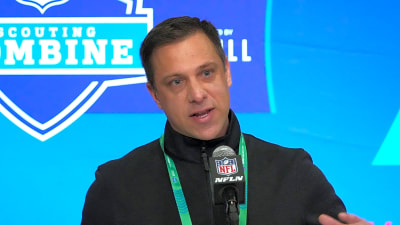
Lucas Glover is 45 years old, from Florida by way of South Carolina, with a career high OWGR ranking of 15th and three wins this decade. Rory McIlroy is 33 years old, from Florida by way of Northern Ireland, with 122 weeks at the world number 1 spot, and three wins this season. The two men have as little in common as two guys with the same job could have, and yet this week, looking out over the Wissahickon Course at Philly Cricket Club, the two reached the same conclusion: Golf is better at 7100 yards.
“7100 [yards], no doubt about it. Look at this Cricket Club course. You have a pitch shot par 3 where the cover is 100 yards, you have a 250 yard uphill par 3 where one side is death, and you have two par 3s that are in between. Four different clubs. Look at the second hole. I played it with a 5-wood and a sand wedge. Wyndham Clark, longer than I am, hit driver right up to the green. We both made 3s. The architect gives you so many choices. At Quail Hollow, we’ll all be hitting it to pretty much the same place.” – Lucas Glover
“Absolutely, it’s a little more strategic. Even today, heavier air, rain, a bit of wind. I drew back on a couple holes, and then I hit driver on a couple. I think there’s a lot of debate about it, but if the golf ball just went a little shorter, this course would be awesome. Not that it isn’t awesome anyway, but right now, for the distances we hit it, it’s probably 500 or 600 yards too short. It would be amazing to be able to play courses like this the way the architect wanted you to play them.” – Rory McIlroy
Both Glover and McIlroy invoked the course architect, A.W. Tillinghast, notable throughout the northeast for courses like Winged Foot, Bethpage Black, and both courses at Baltusrol, and in stirring Tilly from his grave, also stirred up the debate about whether mens professional golf should consider rolling back the golf ball, as the USGA and R&A have suggested. If Tillinghast intended the Wissahickon course to play a different way, and if golf is better at 7100 yards, as Rory and Lucas appear to agree upon, what responsibility does golf have to see to it that those things happen?
BUT WHY?
Opponents to the USGA and R&A’s proposed rollback will often deflect, claiming the distance boom either doesn’t exist or, if it does, is a non-issue. Sometimes they’ll acknowledge the distance boom exists and is an issue, but that rolling back the ball wouldn’t solve the problems. So what are the problems, and why should we bother solving them?
PROBLEM #1: The Course Issue
The first nail the hammer of a rollback would hit is plain: Courses can’t defend themselves from the kind of length these players have now. Not just in a score-to-par sense, either. Strategically speaking, significant course features disappear into afterthoughts when players with distance the architect didn’t predict show up to play them, and elongating courses to reintroduce those features isn’t always an option.
Land isn’t plentiful, nor is it free. Great golf courses bow out of the rotation year after year because they simply don’t challenge the players anymore. A rollback brings some of those courses back into play, but that isn't the only issue we're dealing with.
PROBLEM #2: The Skill Issue
This, to me, is the bigger issue at hand. At the core of the existence of professional golf as a sport is the question, “What skills does pro golf attempt to identify and reward in the golfer?” Golf in the previous century always had a variety of skill profiles that were viable in the pursuit of low scores. The bombers, sure, but also the tacticians, the short game magicians, the surgeons. Ian Woosnam and Fred Couples could win green jackets in back-to-back years with vastly different games. Golf is better when it finds ways to reward a wide variety of skill sets.
It’s not that there are no short game magicians left, it’s just that all the short game magicians are also bombers, and in creating a barrier that only or primarily permits players of a certain distance threshold beyond it, golf has limited the profiles of skills it can reward at the highest level, and has robbed the fans of the experience of watching a greater variety of skill sets on display.
Does a golf ball rollback fix this issue, though? Not really. Not by itself.
In order to fix the second issue, the bigger issue, we have to roll back not just the distance the ball travels, but the spin it has on the way there – a higher-spin ball will reintroduce a premium on ball striking and accuracy, and mitigate some of the advantages enjoyed by the longest hitters. Shrinking the sweet spot on the driver head would do wonders toward the same goal as well. No matter how, golf has to find a way to make it harder to hit the ball as long and as straight as the majority of players today do, and there is no doubt that the equipment, not the natural athleticism or the conditioning of the golfers themselves, is the prime contributor to the easy distance phenomenon.
A RETURN TO NORMALCY
To be honest, I go back and forth on whether pro golf should even exist. The game is more boring, more fractured, more cringe-inducing than it’s ever been. Between the simulator leagues and the creator classics, it’s possible I’m an old man yelling at the clouds, desperate for the game that doesn’t exist anymore. But a lot of what there is to love about golf – the courses, the skill sets – are dissipating into the air around us, leaving barely a trace.
If we aren’t careful, if we don’t take steps the immediate term to address the issues, a lot of what there is to love about golf now, and what there was to love about golf in the recent past, will be wholly irrelevant to the next generation of golf fans, like just another fairway bunker that used to be in play, but isn’t any more.
More must-reads:
- 'Heartbroken beyond words': Remembering Greg Biffle, NASCAR's underappreciated star
- Giannis Antetokounmpo has clear message amid NBA trade rumors
- The 'NFL's active TD-catch leaders' quiz
Breaking News
Trending News
Customize Your Newsletter
 +
+
Get the latest news and rumors, customized to your favorite sports and teams. Emailed daily. Always free!








